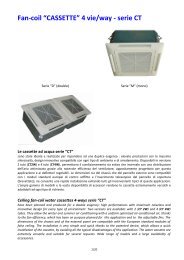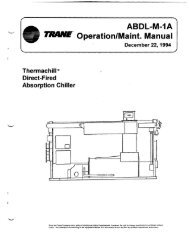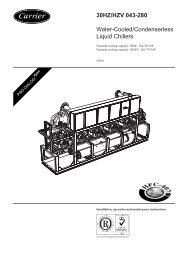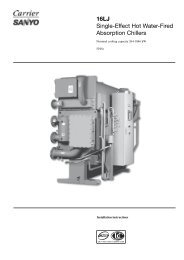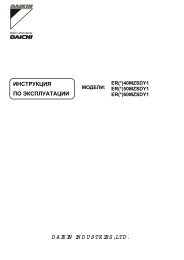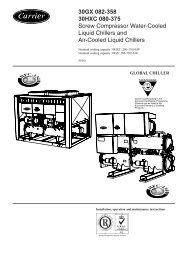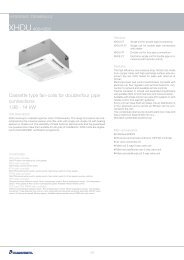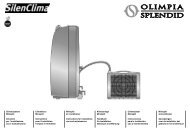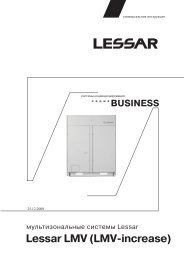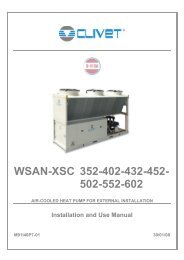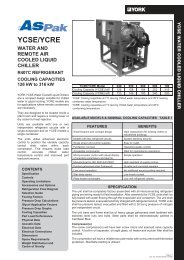MSAT 102-122-142-162-182-202-242
MSAT 102-122-142-162-182-202-242
MSAT 102-122-142-162-182-202-242
Create successful ePaper yourself
Turn your PDF publications into a flip-book with our unique Google optimized e-Paper software.
CHECKING FOR LEAKS<br />
- Carefully check that the valves on the condensing units are closed.<br />
- Connect the pressure gauge assembly to the service test points on the valves.<br />
- Pressurise with refrigerant to 250KPa.<br />
- Close the valves on the pressure gauge assembly, then disconnect the<br />
refrigerant bottle and subsequently connect the nitrogen bottle.<br />
- Open the valves on the pressure gauge.<br />
- Pressurise the system with nitrogen to 1200KPa.<br />
- Carefully check all the pipes using a leak detector or other electronic<br />
instrument, with special attention to the welds and joints in general.<br />
If the necessary equipment is not available, make sure any parts that may give<br />
rise to refrigerant leaks (welds, joints etc.) are accessible.<br />
OUTDOOR UNIT<br />
INDOOR UNIT<br />
Thermostat bulb<br />
Max. height difference<br />
Thermostat bulb<br />
Gas valve<br />
Figure Figura 5 5<br />
Liquid valve<br />
INSTRUCTIONS FOR CORRECT CONNECTION<br />
INTAKE PIPE<br />
- Slope this towards the compressor in the horizontal sections (0.5 %) to ensure<br />
the return of oil to the compressor even under minimum load conditions.<br />
- Carefully insulate the pipe with anti-condensate, closed cell polyethylene,<br />
minimum thickness 9mm.<br />
- If the condensing unit is lower than the evaporating unit (figure 5), install a drain<br />
trap of equal height to the exchanger coil, so as to prevent the return of liquid to<br />
the compressor when the unit is off.<br />
- To avoid fitting a drain trap, install a solenoid valve on the liquid line (see<br />
Figure 6); this is always recommended in any case.<br />
- If the terminal unit is fitted with a thermostat as well as a drain trap, install a<br />
socket (see Figure 5) as near as possible to the unit. This will prevent the bulb of<br />
the thermostat from remaining in contact with the liquid when the unit is off (see<br />
Figure 5).<br />
In the case of connection to our CED-V terminal units, the drain trap is already<br />
fitted inside the unit.<br />
- If the condensing unit is higher than the evaporating unit, only install the socket<br />
(see Fig 7). Note that if the total distance exceeds 7-10 metres, the solenoid<br />
valve must be installed on the liquid line.<br />
- For vertical rises, as well as well the socket also fit an oil collection trap every 6<br />
metres (see Figure 8).<br />
- Use wide-radius curves (no elbows).<br />
- Carefully avoid choking the pipes.<br />
LIQUID PIPES<br />
- If exposed to the sun or passing through areas where the temperature is higher<br />
than the outside temperature, they must insulated, otherwise they can be free.<br />
- Avoid excessive diameters so as to prevent an excess refrigerant charge.<br />
Max. height difference<br />
Figure 6<br />
Figura 6<br />
Figure 7<br />
Figura 7<br />
8 metres<br />
Figure Figura 88<br />
IMPORTANT<br />
When the indoor terminal unit is fitted with a thermostat, if the connection pipes are longer than around 15/20 metres or<br />
alternatively if the system is expected to operate in variable climatic conditions (for example, very different Day/Night outside<br />
air temperature) a liquid receiver of suitable capacity should be installed near the indoor unit.<br />
The liquid receiver performs the following functions:<br />
- It prevents gaseous freon form reaching the expansion device.<br />
- It compensates for the variations in charge that occur in the system due to the change in operating conditions.<br />
- For a certain time it partly compensates for any immeasurable microscopic leaks that occur in the system over time.<br />
- It prevents the excessive flooding of the condenser with the corresponding raising of the condensing temperature/pressure<br />
if the system has been charged with a higher quantity of refrigerant, or if the system was charged in abnormal climatic<br />
conditions.<br />
Having said this, the liquid receiver should always be installed when the connections are very long.<br />
54



